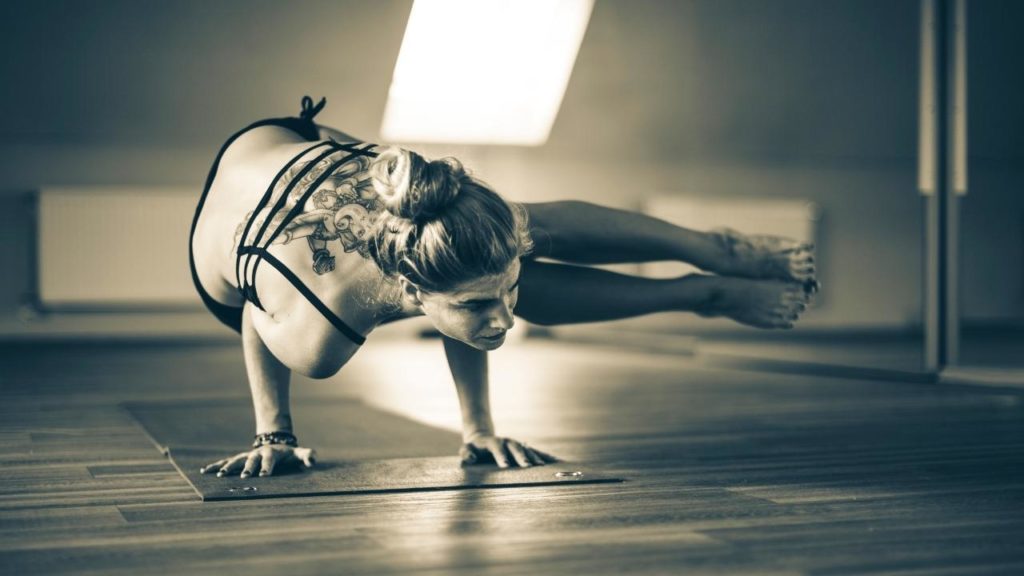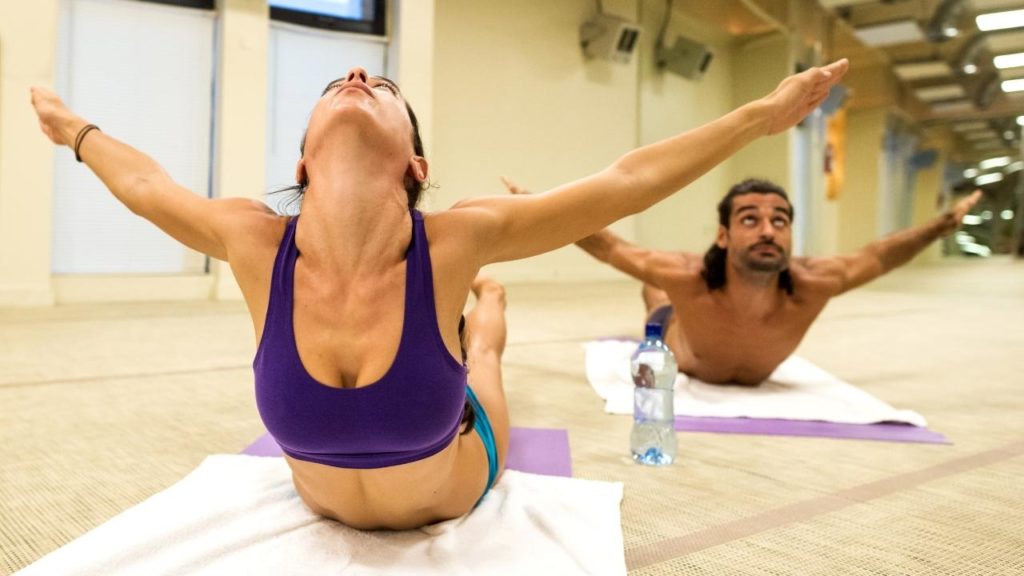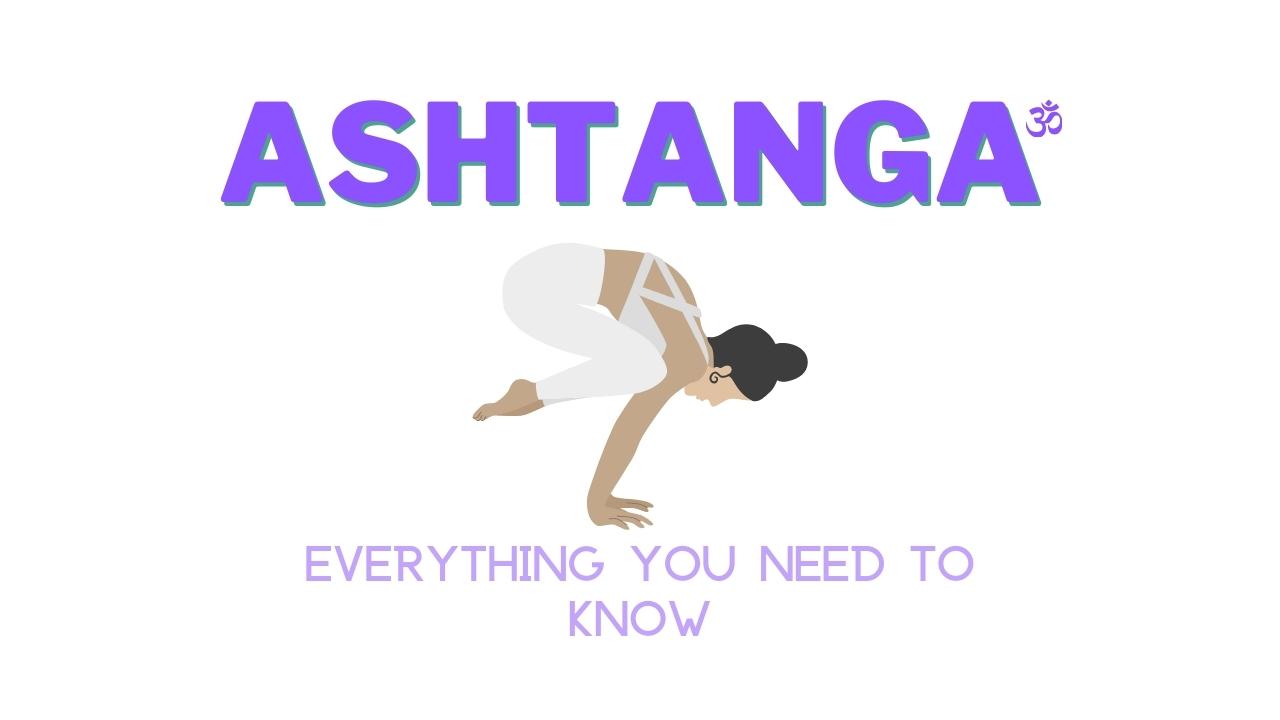Ashtanga Vinyasa Yoga is the supreme discipline when it comes to yoga practice. It is widely considered the most challenging style of yoga consisting of six asana series. While that sounds a lot, most people only practice the first series for months or years before even trying the other sequences because they are just that difficult to do. In this article, we cover everything you need to know about Ashtanga Vinyasa Yoga.
Table of Contents
- Ashtanga Vinyasa Yoga History
- What’s the difference between Ashtanga yoga and Vinyasa yoga?
- Is Ashtanga Vinyasa Yoga for Beginners?
- How do you do Ashtanga Vinyasa Yoga?
- What are the benefits of Ashtanga Vinyasa Yoga?
- Ashtanga Yoga Resources
- Ashtanga Yoga Opening Chant
- Ashtanga Yoga Closing
- FAQ
- Why is Ashtanga not popular?
- How can I make Ashtanga easier?
- Is Ashtanga or Vinyasa better for Weight Loss?
- What kind of Yoga burns the Most Fat?
- Why is Ashtanga so hard?
- How many poses are in the Ashtanga Primary Series?
- Can Ashtanga Change your Body?
- How long does it take to see results from Ashtanga?
- How often should I do Ashtanga?
- When should I practice Ashtanga Yoga?
- Can you do Ashtanga in the Evening?
- Is Ashtanga the hardest Yoga?
- Is Ashtanga Yoga harder than Vinyasa Yoga?
- Conclusion
Ashtanga Vinyasa Yoga History

The Ashtanga Vinyasa Yoga system was founded by Sri Krishnamacharya in the early 1930s. He is considered to be the father of modern yoga, and his teachings have influenced many of the popular yoga styles that exist today, including Iyengar, Bikram, and Power Yoga.
The word “Ashtanga” means “eight limbs” in Sanskrit and refers to the eight elements of yoga:
- Yama (restraints)
- Niyama (observances)
- Asana (postures)
- Pranayama (breath control)
- Pratyahara (sense withdrawal)
- Dharana (concentration)
- Dhyana (meditation)
- Samadhi (absorption)
“Vinyasa” means “breath-synchronized movement,” and the Ashtanga Vinyasa Yoga system is based on a specific sequence of postures that are linked together by the breath. The purpose of this system is to purify the body and mind through the practice of asana, pranayama, and meditation so that the practitioner can achieve self-realization.
The Ashtanga Vinyasa Yoga system was brought to the West by Pattabhi Jois in the late 1960s. Jois began practicing yoga at the age of 12 with Krishnamacharya, and he later went on to teach the Ashtanga Vinyasa Yoga system to students all over the world. Today, there are many different schools of Ashtanga Vinyasa Yoga, but all of them adhere to the same basic principles and practice the same sequence of postures.
David Swenson
David Swenson also contributed to the popularity and rise of Ashtanga Vinyasa Yoga in the western world.
David Swenson is an internationally recognized yoga teacher who has been practicing and teaching Ashtanga Vinyasa Yoga for over 20 years. He is the author of “Ashtanga Yoga: The Practice Manual“, which is widely regarded as the best Ashtanga yoga resource for beginners. He is also the founder of the Asheville School of Yoga. David has also studied with some of the most renowned yoga teachers in the world, including Pattabhi Jois, Sharath Rangaswamy, and Sri K. Pattabhi Jois.
David offers workshops and teacher training worldwide, and he is one of the most sought-after instructors in the Ashtanga Vinyasa Yoga community. In this interview, David shares his insights on Ashtanga Vinyasa Yoga, its history, and its benefits.
Kino McGregor
Kino McGregor is another big influence in Ashtanga Vinyasa Yoga, especially in recent times.
Kino McGregor is a yoga teacher, author, and founder of the Yoga Alliance registered school, Omstars Academy. She has taught yoga for over 15 years and has been featured in magazines such as Yoga Journal and Elle.
Kino’s online platform Omstars is an excellent and widely popular platform to practice Ashtanga Vinyasa Yoga and other yoga styles online, both with recordings and daily live classes. We have been personally using Omstars for the past few years and are very happy with the platform.
Kino offers teacher training, workshops, and retreats all over the world. In this interview, Kino shares her insights on Ashtanga Vinyasa Yoga, its history, and its benefits.
What’s the difference between Ashtanga yoga and Vinyasa yoga?
The main difference between Ashtanga yoga and Vinyasa yoga is that Ashtanga yoga is a set sequence of postures that always is the same, while Vinyasa yoga is a more free-flowing style that can include any of the yogic asanas. Ashtanga yoga is also generally faster-paced and more physically demanding than the usual Vinyasa yoga class.
Is Ashtanga Vinyasa Yoga for Beginners?

If you’re interested in trying Ashtanga Vinyasa Yoga, it’s essential to find a reputable teacher who can safely guide you through the practice. The Ashtanga Vinyasa Yoga system is not for everyone, but if you’re up for the challenge, it can be an incredibly rewarding experience.
There are many different schools of Ashtanga Vinyasa Yoga, so it’s important to find one that’s right for you. If you’re a beginner, we recommend checking out David Swenson’s “Ashtanga Yoga: The Practice Manual” or Kino McGregor’s online platform Omstars. Both of these resources are excellent for beginners and will help you get started on the right foot.
Ashtanga Vinyasa Yoga is a yoga practice that requires some form of dedication. Being able to finish the primary series can be a huge hurdle, as it is so difficult. A lot of the poses included in the primary series are too difficult for beginners, so it is essential to have some guidance in the beginning.
A lot of people try Ashtanga Vinyasa Yoga for the first time and give up right away because they get discouraged by the level of skill of other students or just by the fact that they are not able to finish the primary series.
That is completely normal and should not discourage you from trying. Learning Ashtanga Vinyasa Yoga is a marathon, not a sprint. Always keep in mind that everyone started as a beginner, and it took most people years of practice to even be able to finish the primary series with all of its poses.
If you can find an introductory class, ideally starting with the half-primary series, that would be the ideal start for a beginner.
How do you do Ashtanga Vinyasa Yoga?

Every Ashtanga Vinyasa Yoga practice usually starts with five repetitions of Sun Salutations (Surya Namaskar) A and B. This is usually followed by a standing asana sequence. Then, one of the six series of Ashtanga Vinyasa Yoga is going to be practiced.
The Six Series of Ashtanga Vinyasa Yoga
There are six series of Ashtanga Vinyasa Yoga:
- The first series is called the Primary Series (Yoga Chikitsa), which means yoga therapy. This series is meant to align and cleanse the body.
- The second series is called the Intermediate Series (Nadi Shodhana), which means nerve purification. This series is meant to calm the nervous system.
- The third series is called the Advanced Series (Sthira Bhaga), which means steadiness and energy. This series is meant to build strength and stamina and is further separated into the other Advanced Series:
- Advanced A – Third Series
- Advanced B – Fourth Series
- Advanced C – Fifth Series
- Advanced D – Sixth Series
Originally, there were only four series, but later on, two more series were added by Pattabhi Jois, who said they could be practiced once one has mastered the previous four series.
What are the benefits of Ashtanga Vinyasa Yoga?
The benefits of Ashtanga Vinyasa Yoga are many, but some of the most notable ones are:
- improved flexibility
- increased strength and stamina
- better alignment
- improved breathing
- reduced stress and anxiety
- improved concentration and focus
- increased mood
- builds self-confidence
- increases weight loss
- increases metabolism
- increases longevity
Of course, these are just some of the benefits, and each person will experience different results based on their own practice.
Ashtanga Yoga Resources
If you’re interested in learning more about Ashtanga Vinyasa Yoga, we recommend checking out the following resources:
- David Swenson’s Ashtanga Yoga: The Practice Manual
- Kino McGregor’s online platform Omstars
- Pattabhi Jois’ book Yoga Mala
- Our Ashtanga Section
These resources will provide you with a solid foundation on which to build your Ashtanga Vinyasa Yoga practice. And remember, always keep in mind that everyone started as a beginner, and it took most people years of practice to even be able to finish the primary series with all of its poses. So don’t get discouraged if you can’t do it all right away. Just keep practicing, and you’ll get there in no time.
Ashtanga Yoga Opening Chant
This is the opening chant that is being chanted at every beginning of an Ashtanga class:
| Sanskrit | English |
|---|---|
| Om Vande gurunam charanavinde Sandarsita svatmasukhava bodhe Nishreyase jangalikayamane Samsara halahala mohashantyai Abahu purusakaram Shankachakrasi dharinam Sahasra sirasam svetam Pranamami Patanjalim Om | Om I bow to the lotus feet of the gurus who awakens insight into the happiness of pure being like the jungle healer who brings great well-being relief from delusion, the poison of Samsara the upper body having human form holding a conch, discus and sword having a thousand branched heads of white light I bow to patanjali Om |
Ashtanga Yoga Closing
And this mantra is said at every closing of an Ashtanga class:
| Sanskrit | English |
|---|---|
| svasti prajabhyah paripalayantam nyayena margena mahim mahisah go-brahmanebhyah subham astu nityam lokah samastah sukhino bhavantu | may all be well with mankind may the leaders of the earth protect in every way by keeping to the right path may there be goodness for those who know the earth to be sacred may all the worlds be happy |
FAQ
Why is Ashtanga not popular?
Ashtanga Vinyasa Yoga is not as popular as some of the other yoga styles because it is so difficult. A lot of the poses included in the primary series are too difficult for beginners, so it is essential to have some guidance in the beginning.
A lot of people try Ashtanga for the first time and then give up because they get discouraged by the level of skill of other students or just by the fact that they are not able to finish the primary series. That is completely normal and should not discourage you from trying.
Learning Ashtanga yoga is a marathon, not a sprint. Always keep in mind that everyone started as a beginner, and it took most people years of practice to even be able to finish the primary series with all of its poses.
How can I make Ashtanga easier?
There is no easy way to make Ashtanga Vinyasa Yoga easier. It is a difficult yoga style and requires a lot of dedication and hard work. However, there are a few things you can do to make it easier:
- Find a good teacher: A good teacher will be able to give you modifications and help you progress at your own pace.
- Don’t compare yourself to others: Everyone learns at their own pace, so don’t compare yourself to other students. Just focus on your own practice and progress.
- Start with the primary series or even the half-primary series: The primary series is the foundation of Ashtanga Vinyasa Yoga, so it is essential to start here. Once you have mastered the primary series, you can then move on to the other series.
Is Ashtanga or Vinyasa better for Weight Loss?
There is no definitive answer to this question, as it depends on the individual. Both Ashtanga Vinyasa Yoga and Vinyasa Yoga are excellent for weight loss, but it depends on the person’s own level of fitness and dedication to their practice.
Both styles of yoga will help you burn calories, build muscle, and improve your overall health. The best way to find out which one is better for you is to try both and see which one you like better. Whichever style you choose, make sure to stick with it and practice regularly for the best results.
What kind of Yoga burns the Most Fat?
Also, no definitive answer here. The kind of Yoga that burns the most fat is the kind of Yoga you do regularly.
Regularly practicing Ashtanga is a great way to shed some weight and build muscle, as it is considered harder than most other yoga practices.
Why is Ashtanga so hard?
Ashtanga is difficult because it is a very physically demanding yoga style. It requires a lot of strength, stamina, and flexibility.
The primary series alone includes over 75 different poses and more than 35 Vinyasas, and it can take years to master all of them. Additionally, Ashtanga is sometimes even done in a heated room, making the practice even more challenging.
However, the difficulty of Ashtanga is also what makes it so rewarding. It is a very challenging yoga style, but the rewards are well worth the effort.
How many poses are in the Ashtanga Primary Series?
The Ashtanga Primary Series consists of about 75 poses and more than 35 Vinyasas, including Surya Namaskar A, Surya Namaskar B, standing poses, seated poses, inversions, and backbends.
Can Ashtanga Change your Body?
Yes, Ashtanga Vinyasa Yoga can definitely change your body. It is a very physically demanding yoga style and will help you build muscle and lose weight. Additionally, Ashtanga is also known to improve flexibility, stamina, and overall fitness level.
How long does it take to see results from Ashtanga?
Again, this depends on the individual. Some people see results from Ashtanga Vinyasa Yoga very quickly, while others take longer. However, most people see some results within a few weeks of regular practice.
The best way to see results from Ashtanga is to practice regularly and be patient. Remember that progress takes time, so don’t get discouraged if you don’t see results immediately. Just keep practicing, and eventually, you will start to see the changes in your body.
If you are dedicated to your practice and stick with it, eventually, you will achieve the results you desire.
How often should I do Ashtanga?
Ideally, you should practice Ashtanga Vinyasa Yoga every day. However, this is not always possible for everyone. If you cannot practice every day, aim for at least three to four times per week.
The most important thing is to be consistent with your practice and make sure you are doing it regularly. Even if you can only practice a few times per week, you will still see some benefits from Ashtanga Vinyasa Yoga.
When should I practice Ashtanga Yoga?
The best time to practice Ashtanga Vinyasa Yoga is in the morning, on an empty stomach, and after your bowel movements. However, this is not always possible for everyone. If you cannot practice in the morning, aim for sometime in the afternoon or evening.
Make sure to give yourself at least two hours after eating before practicing Ashtanga. It is also important to practice on an empty stomach so that you can fully focus on your practice and not be distracted by your food.
Can you do Ashtanga in the Evening?
Yes, you can do Ashtanga in the evening. However, it is best to practice in the morning if possible. If you cannot practice in the morning, aim for sometime in the afternoon or evening.
Make sure to give yourself at least two hours after eating before practicing Ashtanga.
Is Ashtanga the hardest Yoga?
Ashtanga Yoga is generally considered to be the hardest form of yoga, but that entirely depends on what your goals are with yoga. If building a meditation practice is your main goal, but you are physically very fit and experienced with yoga, you might find it harder to sit still than going through the Primary Series.
Is Ashtanga Yoga harder than Vinyasa Yoga?
There is no easy answer to this question since it entirely depends on the individual. Some people find Ashtanga Yoga to be harder than Vinyasa Yoga because it is more physically demanding, while others find Vinyasa Yoga to be harder because it requires more mental focus and concentration. Ultimately, it all comes down to what your goals are and what you are personally looking for in yoga practice.
Both Ashtanga Yoga and Vinyasa Yoga have their own unique challenges, so it really depends on which one you are more drawn to. If you are looking for physically demanding yoga practice, Ashtanga Yoga is probably the better option. However, if you are looking for a yoga practice that requires more mental focus and concentration, Vinyasa Yoga might be the better option.
At the end of the day, it all comes down to what you are personally looking for in yoga practice. Try out both Ashtanga Yoga and Vinyasa Yoga and see which one you prefer.
Conclusion
Ashtanga Vinyasa Yoga is an incredibly beneficial practice that can help improve your physical and mental health. However, it is important to remember that progress takes time, so be patient with your practice. Dedicate yourself to regular practice, and eventually, you will start to see the changes in your body. With consistency and dedication, you will eventually achieve the results you desire.
- Ashtanga Yoga is an incredibly beneficial practice that can help improve your physical and mental health.
- It is important to remember that progress takes time, so be patient with your practice.
- Dedicate yourself to regular practice, and you will see results.
- The best time to practice is in the morning on an empty stomach and after bowel movements.
- Find a good teacher you trust before starting to learn Ashtanga yoga yourself with books or videos.
- Don’t be discouraged by other, more skilled students. Focus on your own practice.
If you enjoyed this blog post, please share it with your friends and family! Also, be sure to check out our other blog posts on yoga and meditation for more tips and advice. Thanks for reading!
